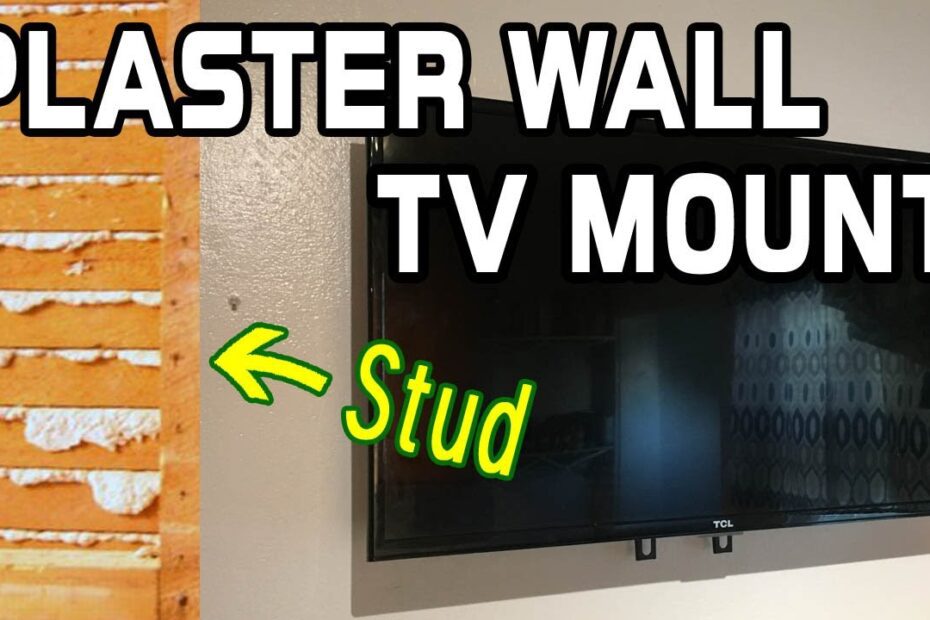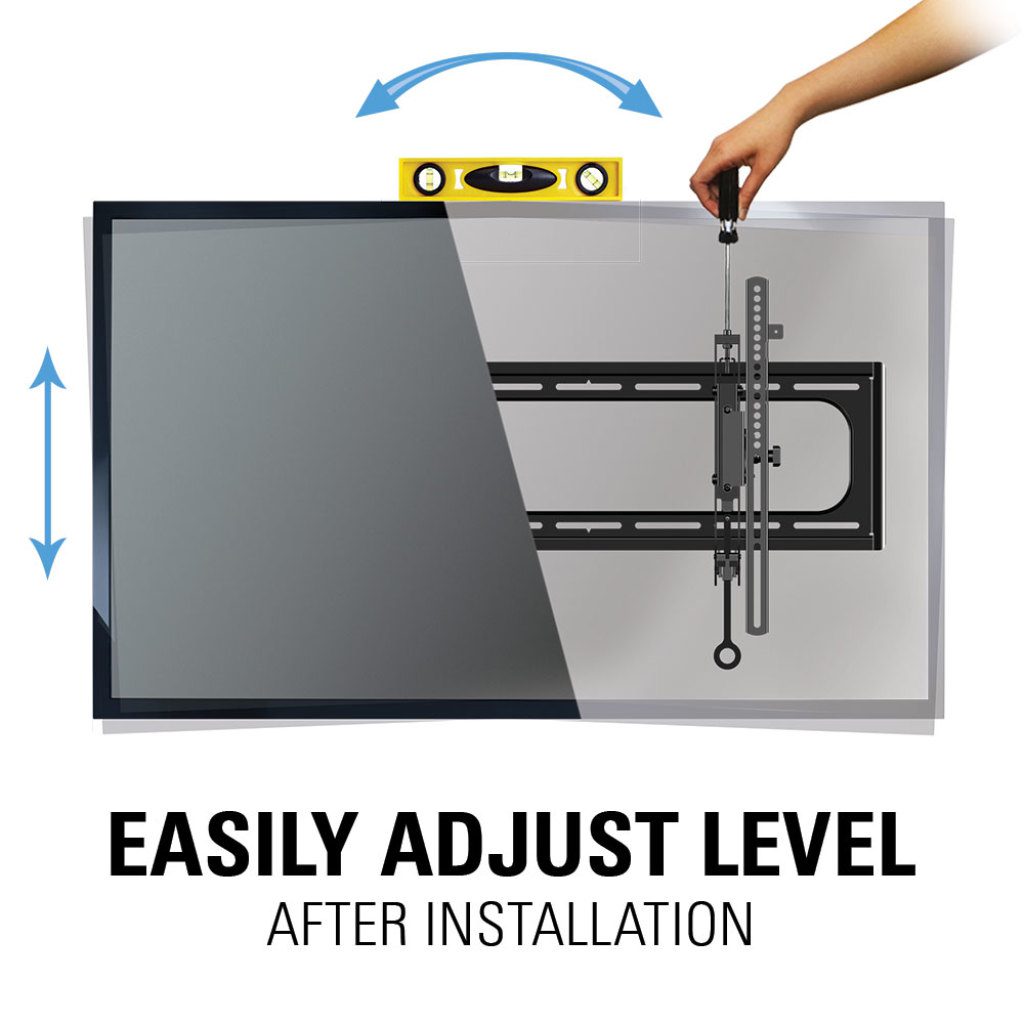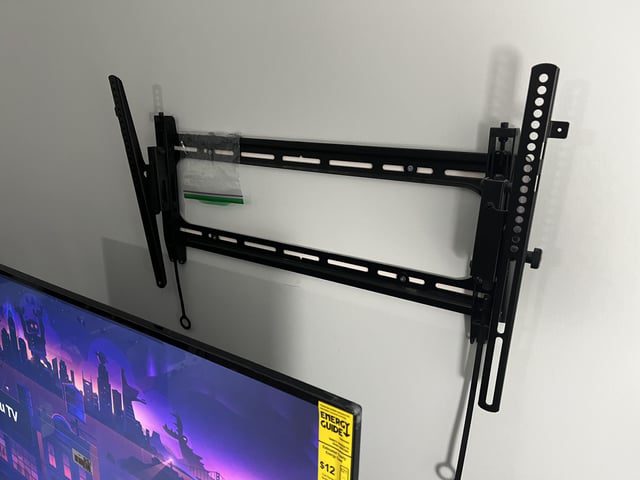To mount a TV on a plaster wall, you will need to use a stud finder to locate the studs, mark them with a pencil, and then use a drill to attach the mounting bracket securely to the studs. Once the bracket is in place, you can hang the TV onto the bracket and ensure it is level before tightening the screws.
Remember to hide the cables and cords for a clean and organized look.
Choosing The Right Mounting Hardware
Mounting your TV on a plaster wall can seem like a daunting task. It’s important to choose the right mounting hardware to ensure your TV is securely attached to the wall. In this section, we’ll discuss the different types of mounts available, the weight capacity and size considerations, as well as how to use a stud finder for plaster walls.
Types Of Mounts
When it comes to mounting your TV on a plaster wall, there are several types of mounts to choose from. Each mount has its own set of advantages and considerations. Here are the most common types of mounts:
- Fixed Mounts: These mounts are a popular choice as they keep your TV securely fixed in one position. They are ideal for rooms where there is no need for adjusting the TV’s angle or height.
- Tilting Mounts: If you want the flexibility of adjusting the viewing angle, a tilting mount is a great option. These mounts allow you to tilt the TV up or down to reduce glare or for better viewing from different areas of the room.
- Full-Motion Mounts: Need the ultimate flexibility? Full-motion mounts can swivel, tilt, and extend, giving you complete control over the TV’s position. These mounts are perfect for rooms where the TV needs to be viewed from multiple angles.
Weight Capacity And Size
Before you choose a mounting hardware, it’s crucial to consider the weight capacity and size. The weight capacity refers to the maximum weight that the mount can support. It’s essential to check the weight of your TV and ensure it falls within the capacity of the mount you choose. Using a mount with insufficient weight capacity can result in a falling TV and potential damage to your wall.
Additionally, you need to consider the size of your TV. Mounts come in different sizes, and it’s important to choose a mount that can accommodate the dimensions of your TV. Most mounts have a recommended size range, so be sure to check that the mount is suitable for your TV’s size.
Stud Finder For Plaster Walls
When mounting a TV on a plaster wall, it’s essential to securely anchor the mount to a stud for maximum stability. Plaster walls can be fragile, so using a stud finder will help you locate the vertical wooden studs behind the plaster. This way, you can attach your mount to the studs for added strength and security.
Using a stud finder is simple. Start by calibrating the stud finder according to the manufacturer’s instructions. Then, run the stud finder along the wall in the desired mounting location. When the stud finder indicates the presence of a stud, mark the spot with a pencil for reference.
Now that you understand the importance of choosing the right mounting hardware, as well as the different types of mounts available, the weight capacity and size considerations, and how to use a stud finder for plaster walls, you’re ready to tackle the task of mounting your TV on a plaster wall with confidence!

Credit: www.wikihow.com
Preparing The Wall
Mounting a TV on a plaster wall requires careful preparation to ensure a safe and secure installation. By following these steps, you can confidently mount your TV and enjoy your favorite shows without worry. In this section, we will discuss the key steps involved in preparing the wall for the TV mount.
Determining The Mounting Location
Before you begin, it’s crucial to determine the ideal location to mount your TV. Consider factors such as viewing angles, furniture arrangement, and the size of the room. Keep in mind that the center of the TV should typically be at eye level when seated.
To determine the precise spot, use a measuring tape and mark the desired height on the wall. Ensure that there are no obstructions, such as light switches or electrical outlets, in the surrounding area. Taking the time to find the perfect mounting location will greatly enhance your viewing experience.
Locating Wall Studs
Locating the wall studs is essential as they provide the necessary support for your TV mount. Start by using a stud finder, a handy tool that detects stud positions behind the plaster. Slide the stud finder horizontally along the wall until it indicates the presence of a stud.
Once you locate a stud, make a small mark on the wall. Repeat this process to find additional studs along the desired mounting area. Keep in mind that studs are typically spaced 16 or 24 inches apart, so make sure to check multiple spots to find the nearest ones.
Drilling Pilot Holes
After locating the wall studs, it’s time to drill pilot holes to secure the TV mount. Pilot holes ensure a clean installation and prevent the plaster from cracking. Use an appropriately sized drill bit that will provide a snug fit for the screws included with your TV mount.
Position the TV mount against the wall, aligning it with your desired location and the wall studs. Then, choose one of the stud locations and drill a pilot hole through the plaster and into the stud. Repeat this step for the remaining studs, ensuring that the holes are level and properly aligned.
Remember to double-check the accuracy of each hole before proceeding. Once the pilot holes are drilled, you can then attach the TV mount securely to the wall using the provided screws.
By properly preparing the plaster wall, you are on your way to safely mounting your TV. Taking the time to determine the mounting location, locate the wall studs, and drill pilot holes will ensure a secure and reliable installation. In the next section, we will discuss the process of attaching the TV mount and mounting your TV onto the plaster wall.
Mounting The Tv
Mounting your TV on a plaster wall is easy with these step-by-step instructions. Avoid common pitfalls and ensure a secure installation for the perfect viewing experience in your home.
Attaching The Mounting Bracket
Before mounting your TV on a plaster wall, you will first need to attach the mounting bracket securely. Follow these steps:
- Locate the studs: Use a stud finder to find the studs in your wall. Mark the location of the studs with a pencil.
- Mark the bracket position: Hold the bracket against the wall, aligning it with the marked stud locations. Mark the screw holes on the wall using a pencil or a marker.
- Drill pilot holes: Use a power drill with the appropriate drill bit to create pilot holes at each marked screw hole on the wall. Make sure the holes are deep enough to accommodate the screws.
- Attach the bracket: Place the bracket against the wall again and align the screw holes with the pilot holes. Insert the screws through the bracket holes and into the pilot holes. Tighten them securely using a screwdriver or a power drill.
Securing The Tv To The Bracket
Once the mounting bracket is attached firmly to the wall, you can proceed to secure the TV to the bracket. Here’s how:
- Find the mounting holes: Locate the mounting holes on the back of your TV. These are usually in a square or rectangular pattern.
- Attach the mounting arms: Depending on the type of mounting bracket you have, you may need to attach the mounting arms or brackets to the back of your TV. Follow the instructions provided with your specific bracket for this step.
- Align the TV: Carefully lift the TV and align the mounting holes on the TV with the corresponding brackets or arms attached to the wall-mounting bracket.
- Secure the TV: Using the provided screws, insert them through the mounting holes on the TV and tighten them until the TV is secure. Make sure to follow the manufacturer’s instructions for your specific TV model.
With these steps, you can successfully mount your TV on a plaster wall, ensuring it is secure and properly aligned. Now you can enjoy your favorite shows and movies with the perfect viewing angle!

Credit: m.youtube.com
Concealing Wires
One way to mount a TV on a plaster wall is by concealing the wires. This can be done by using cable management systems or by running the wires through the walls for a clean and professional look.
Running Wires Through The Wall
When it comes to mounting a TV on a plaster wall, one of the main concerns is concealing the unsightly wires. Nobody wants a mess of tangled cables hanging down from the TV. Running the wires through the wall not only keeps them out of sight but also helps create a clean and organized look for your entertainment area.
Running wires through the wall may sound intimidating, but it is actually a straightforward process that you can easily do yourself. Here’s a step-by-step guide on how to run your TV wires through the wall:
- Locate the studs: Start by finding the studs behind your plaster wall using a stud finder. This will give you a solid structure to anchor your TV mount.
- Plan your route: Decide where you want your wires to exit the wall and plan the route accordingly. It’s best to choose a spot close to an electrical outlet for easy access.
- Make holes: Use a drill with a hole saw attachment to create a hole near the top and bottom of the wall where you want the wires to come out.
- Feed the wires: Once the holes are made, use a fish tape or a wire coat hanger to guide the wires through the wall cavity. Start from the upper hole and pull the wire down to the lower hole.
- Connect the cables: Attach the necessary cables, such as HDMI or Ethernet, to your TV. Make sure to leave some slack behind the TV so you can easily connect and disconnect devices.
- Secure the cables: Use cable clips or adhesive cable management sleeves to secure the wires along the wall and prevent them from dangling.
Using Cable Management Solutions
To further enhance the look of your mounted TV and keep the wires hidden, you can utilize cable management solutions. These solutions offer various methods to neatly organize and conceal your cables:
- Cable raceways: These are plastic or metal channels that you can attach to the wall to create a pathway for your cables. The cables are placed inside the raceway, which can be painted to match your wall color for a seamless look.
- In-wall cable management kits: These kits provide a more professional and permanent solution. They typically involve cutting holes in the wall, attaching special plates, and running the wires through them. The result is a clean, hidden cable installation.
- Cord covers: If you prefer a less invasive option, cord covers are a great choice. These flexible plastic covers come in various lengths and can be easily attached to the wall with adhesive backing. They are available in different colors to blend with your wall.
By using these cable management solutions, you can effectively hide your TV wires and create a polished and clutter-free entertainment area.
Testing And Adjusting The Tv
Making sure your TV is stable and level on a plaster wall is an essential part of the mounting process. In this section, we will discuss how to test the stability and levelness of your TV and make any necessary adjustments to achieve the perfect setup.
Checking Stability And Levelness
Before making any adjustments, it’s crucial to check the stability of your TV. You want to ensure it is securely mounted and won’t wobble or tilt over time. To do this, gently push on the corners and sides of the TV to see if it remains steady. If there is any movement, you may need to readjust the mounting brackets or seek professional help.
Next, let’s focus on achieving a level position for your TV. A level TV not only looks aesthetically pleasing but also improves your viewing experience. To check if your TV is level, you can use a bubble level tool. Place the level horizontally along the top of the TV and adjust the mounting brackets until the bubble is centered, indicating a level position. Repeat this process vertically along the sides of the TV to ensure it is perfectly level in both directions.
Making Final Adjustments
Once you have checked the stability and levelness of your TV, it’s time to make any final adjustments for optimal positioning. Here are a few tips to consider:
- Eye-Level Placement: Position your TV at eye level when you are seated for the best viewing angles.
- Distance from the Wall: Adjust the distance between the back of the TV and the wall to accommodate any cables or additional devices you may have connected.
- Cable Management: Ensure your cables are neatly organized and hidden from view. There are various cable management solutions available, such as cable clips or wall-mounted cable covers.
- Additional Features: Take advantage of any additional features your TV mount may offer, such as tilt or swivel capabilities, to enhance your viewing experience.
In conclusion, testing and adjusting your TV’s stability and levelness on a plaster wall is a crucial step in the mounting process. By following these guidelines, you can ensure your TV is securely mounted, level, and positioned for optimal viewing. Now that you have perfected the placement of your TV, it’s time to sit back, relax, and enjoy your favorite shows and movies in style!

Credit: leslievillegeek.com
Frequently Asked Questions Of How To Mount Tv On Plaster Wall
Can You Wall Mount A Tv On A Plaster Wall?
Yes, you can wall mount a TV on a plaster wall. Just make sure to use appropriate anchors and screws to securely attach the wall mount.
How Do You Mount A Tv On A Hollow Plaster Wall?
To mount a TV on a hollow plaster wall: 1. Find a stud or use a wall anchor for support. 2. Mark the mounting holes on the wall. 3. Drill pilot holes and attach a TV mount. 4. Securely mount the TV onto the bracket.
5. Double-check the stability before finishing.
Do Plaster Walls Have Studs?
Yes, plaster walls typically have studs. Studs are wooden or metal frameworks that support the plaster and provide structural stability to the wall. They are usually placed at regular intervals behind the plaster surface.
What Kind Of Anchor For Plaster Walls?
Use anchors specifically designed for plaster walls to ensure proper installation. These anchors are usually made of metal and provide reliable support.
Conclusion
Mounting your TV on a plaster wall doesn’t have to be a daunting task. By following these simple steps, you can ensure a secure and professional installation. Remember to use the right hardware, locate the studs, and use a stud finder for accuracy.
Take your time to measure and level your TV before mounting it. With the right tools and techniques, you can enjoy your favorite shows and movies with peace of mind. Happy mounting!
- Unleash the Potential: Exploring the World of Ceiling TV Mounts - February 15, 2024
- How to Mount a Tv on a Swivel Stand - February 15, 2024
- How to Hang Tv Outside - February 14, 2024


